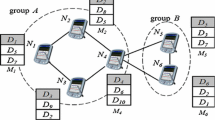Abstract
An opportunistic network (OPPNET) consists of diverse mobile nodes with various mobility patterns. Numerous mobility patterns and the resource constraints of mobile nodes lead to network partitioning that result in system performance degradation including low data accessibility. In a traditional mobile ad hoc network (MANET) which is similar to an OPPNET, replica allocation schemes have been proposed to increase data accessibility. Although the schemes are efficient in a MANET, they may not be directly applicable to an OPPNET because the schemes are based on a grouping of mobile nodes. It is very difficult to build groups based on network topology in an OPPNET because a node in an OPPNET does not keep its network topology information. In this paper, we propose a novel replica allocation scheme for an opportunistic network called the Snooping-based Fully Distributed replica allocation scheme. The proposed scheme allocates replicas in a fully distributed manner without grouping to reduce the communication cost, and fetches allocated replicas utilizing a novel candidate list concept to achieve high data accessibility. In the proposed scheme, a node can fetch replicas opportunistically based on the candidate list. Consequently, the proposed replica allocation scheme achieves high data accessibility while reducing the communication cost significantly. Extensive simulation results demonstrate that the proposed scheme reduces the communication cost and improves data accessibility over traditional schemes.











Similar content being viewed by others
Notes
The nearby nodes are defined as the nodes that have been connected to the current node with one hop or multiple hops and have passed some data items among the nodes.
References
Conti, M., Giordano, S., May, M., & Passarella, A. (2010). From opportunistic networks to opportunistic computing. IEEE Communications Magazine, 48(9), 126–139.
Conti, M., & Kumar, M. (2010). Opportunities in opportunistic computing. IEEE Computer, 43(1), 42–50.
Pelusi, L., Passarella, A., & Conti, M. (2006). Opportunistic networking: Data forwarding in disconnected mobile ad hoc networks. IEEE Communications Magazine, 44(11), 134–141.
Juang, P., Oki, H., Wang, Y., Martonosi, M., Peh, L. S., & Rubenstein, D. (2002). Energy-efficient computing for wildlife tracking: Design tradeoffs and early experiences with zebranet. In Proceedings of ASPLOS (pp. 96–107).
Choi, J., Shim, K., Lee, S., & Wu, K. (2012). Handling selfishness in replica allocation over a mobile ad hoc network. IEEE Transactions on Mobile Computing, 11(2), 278–291.
Hara, T. (2001). Effective replica allocation in ad hoc networks for improving data accessibility. In Proceedings of IEEE INFOCOM (pp. 1568–1576).
Shinohara, M., Hayashi, H., Hara, T., & Nishio, S. (2006). Replica allocation considering power consumption in mobile ad hoc networks. In Proceedings of PerCom (pp. 13–17).
Yen, Y. S., Wu, J. Z., Chung, B. Y., & Chao, H. C. (2009). A novel energy-efficient replica allocation within one-hop groups (ERAOG) in MANET. In Proceedings of CHINACOM (pp. 1–9).
Martin, N., & England, J. (2011). Mathematical theory of entropy. New York: Cambridge University Press.
Cao, G., Yin, L., & Das, C. R. (2004). Cooperative cache-based data access in ad hoc networks. IEEE Computer, 37(2), 32–39.
Chen, L. J., Yu, C. H., Sun, T., Chen, Y. C., & Chu, H. (2006). A hybrid routing approach for opportunistic networks. In Proceedings of CHANTS (pp. 213–220).
Ramanathan, R., Hansen, R., Basu, P., Rosales-Hain, R., & Krishnan, R. (2007). Prioritized epidemic routing for opportunistic networks. In Proceedings of Mobisys (pp. 62–66).
Burns, B., Brock, O., & Levine, B. N. (2005). MV routing and capacity building in disruption tolerant networks. In Proceedings of IEEE INFOCOM (pp. 398–408).
Small, T., & Haas, Z. J. (2003). The shared wireless infostation model: A new ad hoc networking paradigm (or where there is a whale, there is a way). In Proceedings of ACM MobiHoc (pp. 233–244).
Jain, S., Shah, R., Brunette, W., Borriello, G., & Roy, S. (2006). Exploiting mobility for energy efficient data collection in wireless sensor networks. Mobile Networks and Applications, 11(3), 327–339.
Krifa, A., Barakat, C., & Spyropoulos, T. (2011). MobiTrade: Trading content in disruption tolerant networks. In Proceedings of CHANTS (pp. 31–36).
Boldrini, C., Conti, M., & Passarella, A. (2008). Context and resource awareness in opportunistic network data dissemination. In Proceedings of WoWMoM (pp. 1–6).
Lenders, V., Karlsson, G., & May, M. (2007). Wireless Ad Hoc Podcasting. In Sensor, mesh and ad hoc communications and networks (pp. 273–283).
Pantazopoulos, P., Stavrakakis, I., Passarella, A., & Conti, M. (2010). Efficient social-aware content placement in opportunistic networks. In Proceedings of WONS (pp. 17–24).
Reich, J., & Chaintreau, A. (2009). The age of impatience: Optimal replication schemes for opportunistic networks. In Proceedings of CoNEXT (pp. 85–96).
Ma, Y., Kibria, M. R., & Jamalipour, A. (2008). Cache-based content delivery in opportunistic mobile ad hoc networks. In Proceedings of IEEE GLOBECOM (pp. 1–5).
Zhuo, X., Li, Q., Cao, G., Dai, Y., Szymanski, B., & Porta, T. L. (2011) Social-based cooperative caching in DTNs: A contact duration aware approach. In Proceedings of MASS (pp. 92–101).
Boldrini, C., & Passarella, A. (2010). HCMM: Modeling spatial and temporal properties of human mobility driven by users’ social relationships. Computer Communications, 33(9), 1056–1074.
The Network Simulator NS-3. http://www.nsnam.org.
Boldrini, C., Conti, M., & Passarella, A. (2008). ContentPlace: Social-aware data dissemination in opportunistic networks. In Proceedings of MSWiM (pp. 203–210).
Acknowledgments
This research was supported by Basic Science Research Program through the National Research Foundation of Korea (NRF) funded by the Ministry of Education, Science and Technology (2013R1A1A2011114).
Author information
Authors and Affiliations
Corresponding author
Rights and permissions
About this article
Cite this article
Yoon, JH., Choi, JH., Lee, KJ. et al. A fully distributed replica allocation scheme for an opportunistic network. Wireless Netw 20, 733–745 (2014). https://doi.org/10.1007/s11276-013-0641-6
Published:
Issue Date:
DOI: https://doi.org/10.1007/s11276-013-0641-6




